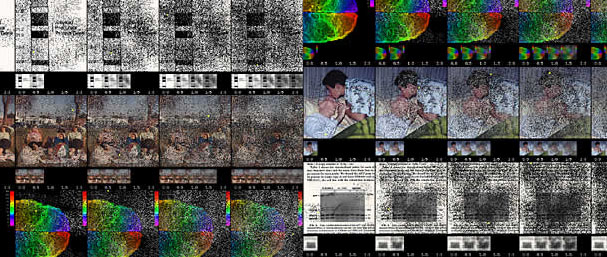In the installation, a series of images from daily life, Alzheimer’s genetic research and neuroscience, are converted to sound, transmitted from speaker to microphone, then reconstructed and transformed, tone by tone. The space between speaker and microphone, at once physical, subjective and ephemeral, of signal sent and received, makes the transmission vulnerable to presence. Any ambient sound haphazardly or purposefully generated by a viewer becomes the encoding of their presence during the transmittal process altering what is eventually received. The result is concomitant re-construction and degradation, a simultaneous gain and loss. This process engages phenomenological, cultural, genetic and neuro-scientific aspects of memory and memory loss, as well as the methodology and aesthetics of science. The image sampling and processing evokes aspects of empiricism, such as time-based sampling, randomization, controls, repetition and objectivity. The image database invokes the notion of personal identity as composed of data or information, at once qualitative and quantitative. As the process continues we are asked to consider: If memory both constructs and is a container for the Self, what is our experience of Self when our memories are lost or significantly altered?
Installation: The installation is comprised of a database of images of daily life and neuroscience, [1] and data from research on the genetics of Alzheimer’s, including that carried out by the artist in the mapping of Alzheimer Amyloid Precursor Protein to Chromosome 21. [2] The images are processed (sonified, degraded, sampled and saved) using custom code also written by the artist. As an image is called up from the database, a small yellow cursor pinpoints the location where the pixel value will be sampled and sonified at every half second. Through this sonification, reminiscent of the tones made by heart and oxygen monitors at patient bedsides, the image tells itself to itself. As this recounting occurs, a microphone samples the sound level, taking in both the tone and any ambient noise. Each image is processed and sampled over a period of two minutes, during which viewers may alter the image. Sampling occurs initially at time = 0.0, then every thirty seconds thereafter until the two minutes is concluded, for a total of five sample points. Sampling is accomplished by saving a thumbnail version of the image in its various stages of processing/alteration and displaying it beneath the larger image. At the end of the two minutes, the final altered version of the image is saved as a thumbnail to an archive and displayed on an alternate screen. The total duration for the processing of all images in the database is approximately seven hours, after which all images have been altered by viewer interaction and final samples saved to the daily archive.
Methodology: A random pixel in the image is selected for sampling. Its color value is evaluated and used to set the volume of a tone to be emitted by the speaker. As the speaker emits a tone at the specified volume a digital to analog conversion is accomplished. The microphone picks up the tone and any additional ambient sound, yet its sensitivity is insufficient to accomplish a 1:1 registration of the emitted tone. This loss of fidelity is important to both process and metaphor in this work. The sound level registered by the microphone is converted to a number from 0 to 255 and used to set a grayscale value, thus accomplishing an analog to digital conversion. The grayscale value is simultaneously visualized on a 4″ LCD CCFT monitor, and used to overwrite the original pixel sampled and another set of 250 random pixels surrounding it. The cycle repeats every one-half second, with a total of 500 pixels overwritten per second. At the end of thirty seconds, the image is sampled, the status of the image is recorded, and a thumbnail image generated and displayed along with the appropriate time marker. Time markers are: 0.0, 0.5, 1.0, 1.5, and 2.0. At the end of two minutes, a final sample is taken. An archive thumbnail is generated, which is stored in a progressively accruing daily collection and displayed on a monitor.
Metaphors and Processes: Metaphors and processes in The Trajectory of Forgetting engage various aspects of memory and memory loss, as well as scientific methodology. The first is that memory constructs continuity of consciousness and our sense of self. Second, that in order to form long term memory traces, the immediate record of perception is not sufficient. We tend to review an event consciously, repeating it, in order to create a long-term memory trace and, in essence, retell the event, our story, to ourselves repeatedly in order to commit it to memory. Third is that the location where memory is stored is coexistent with the location of its erasure. Fourth is that in neurodegenerative disorders, such as Alzheimer’s, there is a progressive loss of cognitive function and memory, associated with the inability to form short and long term memory which leads to an altered sense of Self, which is not simply a void, but an altered experience of Self. And fifth, is that upon extensive dementia, the sense of the Self, which the person held prior to the disorder, is now held in the collective memory of those in their personal network. The image sampling and processing evokes aspects of scientific methodology necessary for empiricism, such as time-based sampling, randomization as a control, repetition and objectivity. The image database invokes the notion of personal identity as composed of data, at once qualitative and quantitative.
It is expected that in the years 2002-2005 “more data will be generated than during all previous human history.” [3] Databases are thus an increasingly necessary component for negotiating the “information society” with its resulting information overload and impact on identity. The installation uses a database of digital images as metaphor for individual and collective memory. It functions as the location of both storage and erasure of memory and identity which has been reduced to data in the digital image, much as in genetic fingerprinting or statistical demographics and collective memory structures which contain other’s memories of an individual. It also parallels the physiological co-location of memory storage and erasure.
The digital content of each image file, specifically the pixel color values, stands as the both the narrative content used to review and retell the event in forming and erasing memory. The database of images invokes the general notion of memory by including images of both daily life and neuroscience. As an image is called up from the database, a small yellow cursor pinpoints the location where the pixel value will be sampled and sonified at every half second. Through this sonification, reminiscent of the tones made by heart and oxygen monitors at patient bedsides, the image tells itself to itself. As this recounting occurs, the microphone samples the sound level, taking in both the tone and any ambient noise. As the microphone does not possess the ability to register the sound level with absolute fidelity, there is a loss that occurs in this transmission, much as there is loss in accuracy when reviewing events in the creating of memory traces as exemplified by the inaccuracies in eye-witness accounts, or the distortion of a received signal due to the inclusion of noise in the transmission. [4]
This sampling and recording process is a way in which the scientific tradition of empiricism becomes operationalized in the installation, as well as subtly raising one’s awareness of the relationship between the information and aesthetics resident in scientific images used for representing research data and the point of view of their “producer”. The process commences immediately as the image is projected and runs for the duration for two minutes at the end of which the image is altered, appearing degraded, and is stored in an archive for display. Each image in turn is processed and archived and displayed on the LCD monitor, reflecting the daily trajectory of the degradation (memory loss) as well as encoding the sounds generated by visitors to the gallery into the alteration of the image. Each day the random sampling, degradation, and collection of all images in the database requires seven hours to complete. In observing the archive collection of processed images, it is important to note that despite significant degradation, there is some resemblance to the original when presented in the context of the collection, yet individually, when viewed in the large projected format at the end of the two minute process, the image seems so degraded/altered that the resemblance to the original is difficult to ascertain. This duality symbolizes the altered sense of Self experienced by individuals with extensive memory loss, such as in Alzheimer’s Dementia, wherein a sense of Self is retained, yet it is not that which is understood as part of ordinary consciousness. The repetitive and continual nature of this processing evokes the daily repetition and continuity inherent in creating memory and identity, memory loss and the altered state of Self-awareness during processes such as Alzheimer’s dementia, as well as in the methodologies applied in the empiricism of scientific practice.

